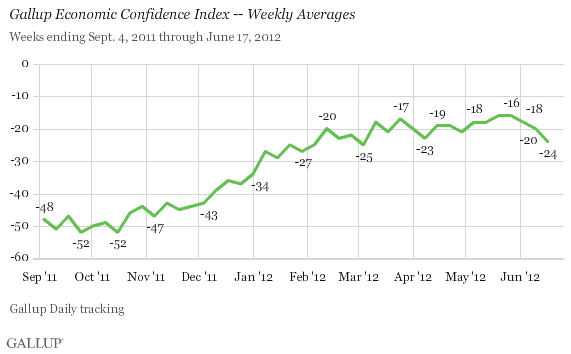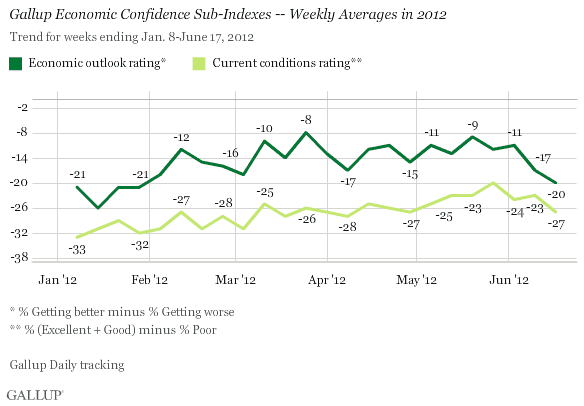PRINCETON, NJ -- The Gallup Economic Confidence Index fell to -24 for the week ending June 17, the third straight week of decline. The index is down four points from the prior week and eight points since late May, when it had reached a four-year best of -16.

Gallup routinely sees slight one-week declines in confidence and occasional two-week declines, but has not recorded a three-week decline since last summer, when the index fell for four straight weeks spanning July 11 through Aug. 7.
The latest sag in confidence puts the weekly Gallup Economic Confidence Index at its most negative level since late February, after a three-month stretch when it had plateaued near -20. Both components of the index -- Americans' ratings of current economic conditions and their perceptions of the economy's direction -- worsened in the past week, to -27 and -20, respectively. However, while current conditions ratings have fluctuated near the -27 mark all year, Americans' economic outlook hasn't registered below -18 since late January.

Economic confidence fell among all three major party groups in the past week, but since the start of the recent decline in late May, it has slipped more among Republicans (down 12 points) and Democrats (down 10 points) than among independents (down four points).

Bottom Line
After improving to as much as -16 in recent weeks, the Gallup Economic Confidence Index has receded to -24 over the first three weeks of June. With the stock market up slightly since the start of the month, gas prices down slightly, and President Barack Obama's job approval rating holding fairly steady in the mid- to high 40s, it is not clear what has caused Americans' overall economic views to sour, although the volatile situation in Europe could be having an effect. To the extent the decline is a delayed reaction to the government's disappointing May employment report, the picture could improve in July if the next labor report mirrors Gallup's data indicating that seasonally adjusted unemployment may be trending down this month.
Gallup.com reports results from these indexes in daily, weekly, and monthly averages and in Gallup.com stories. Complete trend data are always available to view and export in the following charts:
Daily: Employment, Economic Confidence, Job Creation, Consumer Spending
Weekly: Employment, Economic Confidence, Job Creation, Consumer Spending
Read more about Gallup's economic measures.
View our economic release schedule.
Survey Methods
Results are based on telephone interviews conducted as part of Gallup Daily tracking June 11-17, 2012, with a random sample of 3,481 adults, aged 18 and older, living in all 50 U.S. states and the District of Columbia.
For results based on the total sample of national adults, one can say with 95% confidence that the maximum margin of sampling error is ±2 percentage points.
Interviews are conducted with respondents on landline telephones and cellular phones, with interviews conducted in Spanish for respondents who are primarily Spanish-speaking. Each sample includes a minimum quota of 400 cell phone respondents and 600 landline respondents per 1,000 national adults, with additional minimum quotas among landline respondents by region. Landline telephone numbers are chosen at random among listed telephone numbers. Cell phone numbers are selected using random-digit-dial methods. Landline respondents are chosen at random within each household on the basis of which member had the most recent birthday.
Samples are weighted by gender, age, race, Hispanic ethnicity, education, region, adults in the household, and phone status (cell phone only/landline only/both, cell phone mostly, and having an unlisted landline number). Demographic weighting targets are based on the March 2011 Current Population Survey figures for the aged 18 and older non-institutionalized population living in U.S. telephone households. All reported margins of sampling error include the computed design effects for weighting and sample design.
The questions reported here were asked of a random half-sample of respondents for seven nights on the Gallup Daily tracking survey.
In addition to sampling error, question wording and practical difficulties in conducting surveys can introduce error or bias into the findings of public opinion polls.
For more details on Gallup's polling methodology, visit www.gallup.com.
